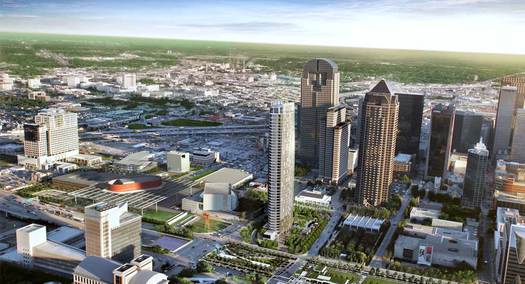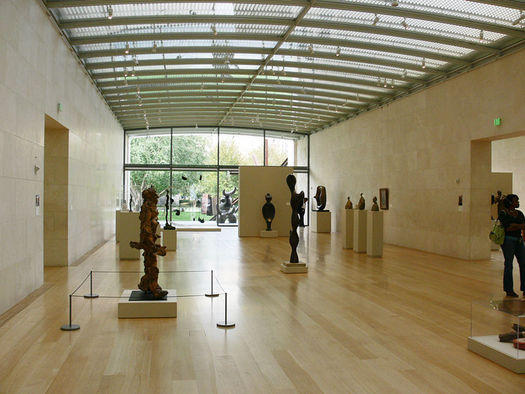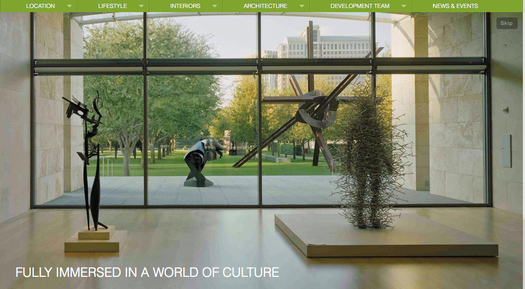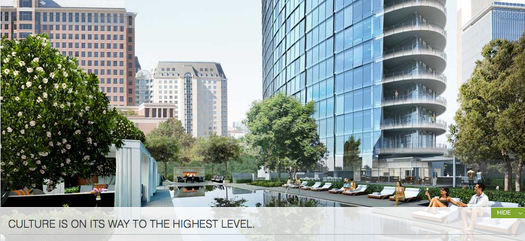
Museum Tower of Dallas, rendered
I admit that when I first read about the trouble in Dallas, I was wryly and perhaps inappropriately amused: an under-construction 42-story condo’s glass exterior is reflecting so much sunlight into a neighboring museum and its sculpture garden that it’s “threatening artworks in the galleries, burning the plants in the center’s garden and blinding visitors with its glare.” That was in May, and I more or less assumed the issue would be resolved; it was only this week that I realized that there's something more going on here — something between drama and parable, turning on the notion of the villainous structure.
It turns out that Tom Luce, a relatively big-wheel Dallas attorney who’s been brought in to mediate the matter, has some kind of media gag order on the negotiators, but this evidently doesn’t apply to Renzo Piano. “You have an aggressor and you have a victim,” Piano, who was recently in the area working on something else, tells The Dallas Morning News, which described him as “emotional.” As one of the architects (with Peter Walker) who designed the museum in question, Piano counts himself a victim, of course. And his blunt casting of the situation at hand was the first step in my understanding of the deeper story here. (And caused me to sink a lot more time soaking up details than I intended, like someone discovering a show belatedly and gorging on a whole season of episodes in one day.)

The Nasher Sculpture Center, via Wikipedia
So a pause to review basic plot elements. The museum is The Nasher Sculpture Center, which opened in 2003, and was considered a kind cultural anchor to a downtown neighborhood — rebranded “The Dallas Arts District” — that would benefit from development. Development has come in part in the form of the Museum Tower, one of those projects deploying the cunning urban-renewal strategy of boosting a neighborhood’s vitality by adding a bunch of millionaires: Units in the Museum Tower reportedly go for $1 million to $5.4 million. (Some budding Richard Florida ought to come up with a snappy nickname for this special category of citizen — “The Upper Class,” perhaps?) Evidently a perfect-storm combination of its size, slightly convex shape, specific orientation, and reflective surface are coming together in a glaring problem. For more details on twists and turns leading to the present dispute, see this Morning News story from March.
But to fast-forward back to the recent Piano comments, I was struck by some of the language he and others are using. Piano refers to the light now threatening the museum as “radiation.” And he warns that the condo will "kill the very thing [its owners] named the building after." Meanwhile, a D Magazine article on the fiasco is titled “The Towering Inferno;” on a Dallas public radio show, one architect guest observed that the building seemed to “raygun” reflected sunlight at its neighbor.
Suddenly the dispute takes on monster-movie tones, and in a sense, the Museum Tower is a monster — like Frankenstein’s, constructed with no ill intent, but transformed by its design flaws into a civic menace. Possibly it will soon begin to tilt around, directing its mighty glare onto other surrounding structures, or will even unmoor itself completely, stalking the city and "raygunning" powerful “radiation” beams that “kill” every cultural institution in the Metroplex.
Okay, I’m being silly, but it’s hard (well, for me) not to daydream about built retaliation. Perhaps the museum should defend itself with a battery of large reflective surfaces that bounce all that “radiation” back onto the Museum Tower with such force that the latter is completely destroyed, saving the day for the higher arts in North Texas.
Then again, maybe my speculations are superfluous, given how impressive this story is without them. I did some time in Dallas in the early 1990s, and have certain affection for the place. (Thus I still look at the Morning News online, all these years later.) I also have a particular reading of the city that sometimes gets me in trouble, but I’m afraid this whole drama plays right into it. The notion of a museum laid waste by the glare from an opulent condo — a gleaming façade and its collateral damage — at first amused me because it just seemed so perfectly Dallas. Plus that name, “Museum Tower,” borders on the parodic, like the Sophisticated Monolith or Highbrow Condos, as is the associated Web site’s relentless invocation of “culture” juxtaposed with glitzy leisure.


Culture as attraction, on the Museum Tower's site.
But what finally makes the drama compelling isn’t the specifc setting at all, it’s the near-universality of the theme. Just as Godzilla is said to have personified (or I guess monsterfied) fears of the atomic age and its consequences, the Museum Tower embodies (or I suppose embuildings) familiar worries around space and control that animate countless disputes over blocked views, neighbors’ constructions projects, the locations of prisons and waste disposal centers.
The built villain unnerves precisely because it is so unpredictable, doing its damage from a distance, and often emerging from and feeding upon the very codes, zoning laws, and even design innovations meant to thwart it. Surely the Museum Tower drama will conclude with the thing being subdued by some heroics or other. But bet on this: Here or elsewhere, there are many sequels to come.
